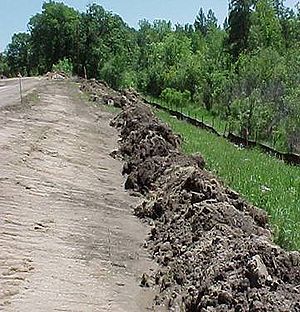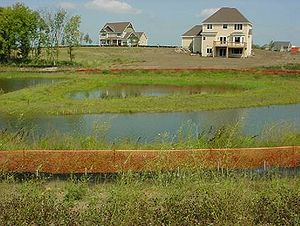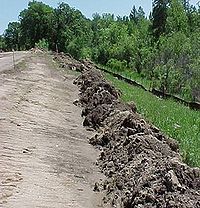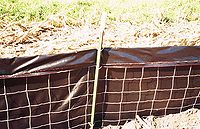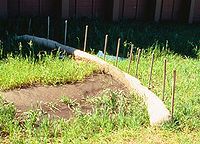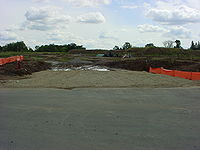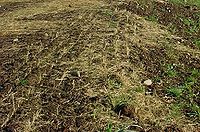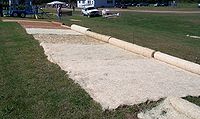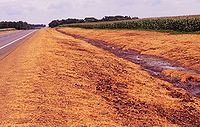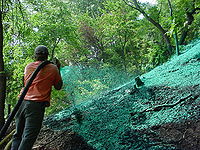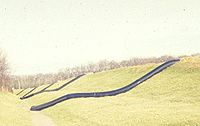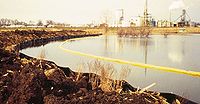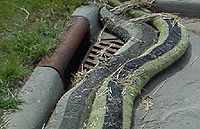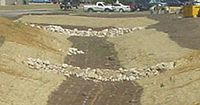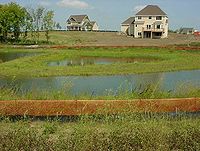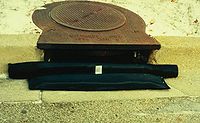
Difference between revisions of "Temporary construction erosion and sediment control"
m |
m |
||
| Line 17: | Line 17: | ||
=='''Permits'''== | =='''Permits'''== | ||
| − | Projects disturbing 1 acre or more of land or a common plan of development or sale that disturbs greater than 1 acre will require a National Pollutant Discharge Elimination System (NPDES) [ | + | Projects disturbing 1 acre or more of land or a common plan of development or sale that disturbs greater than 1 acre will require a National Pollutant Discharge Elimination System (NPDES) [https://stormwater.pca.state.mn.us/index.php?title=2018_Minnesota_Construction_Stormwater_Permit Construction Stormwater Permit] from the Minnesota Pollution Control Agency (MPCA). The size threshold can be smaller if the site is a part of a “common plan of development or sale” and if the larger common plan will ultimately disturb more than 1 acre. The permit requires the establishment of a Stormwater Pollution Prevention Plan (SWPPP) for the construction site. |
Other Minnesota agencies requiring permits typically might include watersheds, municipalities, and soil and water conservation districts. | Other Minnesota agencies requiring permits typically might include watersheds, municipalities, and soil and water conservation districts. | ||
Revision as of 13:37, 29 August 2018
Temporary construction erosion and sediment control is the practice of preventing or reducing the movement of sediment from a site during construction through the implementation of man-made structures, land management techniques, or natural processes. This page does not contain detail on the use of specific BMPs but instead merely discusses their use and refers the reader to other useful resources for detail.
Contents
Introduction
Temporary construction erosion and sediment control limits the amount of sediment that is carried into lakes, streams and rivers by storm water runoff. Sediment carries nutrients and pollutants that degrade water resources and harm aquatic wildlife. Proper planning of construction site activities greatly reduces the impact of soil disturbance activities on nearby resources and diminishes the need for costly restorations. A construction plan that limits sediment disturbance in potential problem areas and uses effective temporary sediment control practices will lessen negative impacts to local water resources and natural areas.
Planning
To establish a construction plan that will minimize sediment movement, designers will need information on existing site conditions and neighboring resources that require special consideration including water bodies, natural areas, bluffs and other highly erodible or sensitive areas. Construction activities should be designed in a manner that minimizes overall soil disturbance and phases areas of disturbance such that the amount of land disturbed at any one time is reduced. This type of planning will limit the need for larger structural sediment control solutions. Additionally, the designer should determine which local, state, and federal agencies require permits for the type of work planned. The site plan will need to account for the requirements of all agencies issuing permits.
Permits
Projects disturbing 1 acre or more of land or a common plan of development or sale that disturbs greater than 1 acre will require a National Pollutant Discharge Elimination System (NPDES) Construction Stormwater Permit from the Minnesota Pollution Control Agency (MPCA). The size threshold can be smaller if the site is a part of a “common plan of development or sale” and if the larger common plan will ultimately disturb more than 1 acre. The permit requires the establishment of a Stormwater Pollution Prevention Plan (SWPPP) for the construction site.
Other Minnesota agencies requiring permits typically might include watersheds, municipalities, and soil and water conservation districts.
Sequencing activities
The practices included in the site plan and SWPPP will need to control runoff, stabilize slopes and exposed soils, and limit the movement of soils into drainage systems and natural areas. A key factor in accomplishing these goals is the sequencing of construction activities such that the minimum possible area is disturbed at any one time. Initial site work should include establishing protective buffer zones adjacent to onsite resources that require protection and setting up perimeter sediment controls.
During the course of construction, a variety of erosion prevention and sediment control practices may be necessary in order to stabilize slopes and drainageways, protect inlets to the storm water conveyance system, limit gully formation, and capture sediment. Several practices can be used as temporary erosion and sediment control practices and these can be used to meet NPDES requirements (see temporary construction erosion and sediment control). Temporary seeding is not erosion protection or sediment control until vegetation is established or until the area is protected with an erosion control blanket. Projects that are actively under construction in winter/frozen months should include additional inspection and clean-up activities. Temporary sediment basins should be sized to include extra storage for snowmelt.
Inspection and maintenance
A final key element to ensure effectiveness of the erosion and sediment control plan is the implementation of an inspection and maintenance program. Frequent inspection and maintenance activities ensure that the installed temporary sediment control practices are operating effectively throughout the course of the project.
Overview of temporary sediment control practices
- Vegetated Buffers
- Uses: erosion control
- Areas to Use
- Perimeter
- Slopes
- Drainageways
- Around Trees, Water Bodies, Natural Areas
- Method: Vegetated buffers are areas designated to remain undisturbed in order to protect trees, lakes, bluffs, or natural areas. Buffers should be marked and maintained around all resources requiring protection.
- NPDES Construction Stormwater Permit Requirement
This fact sheet provides information on permit requirements for site stabilization.
- Silt Fence
- Uses: sediment control
- Areas to Use
- Perimeter
- Slopes
- Drainageways
- Other: Drainage System Inlets
- Method: Silt fence filters sediment from runoff by allowing water to pass through a geotextile fabric or by creating a pool to allow sediment to drop out of the water column. Silt fence is installed primarily at downslope boundaries of the work area but can also be used for inlet protection, and around the perimeter of stockpiles
- NPDES General Construction Stormwater Permit Requirement
This fact sheet provides information on permit requirements for site stabilization.
- Fiber Log
- Areas to Use
- Sediment Control
- Perimeter
- Slopes
- Drainageways
- Other
- Drainage System Inlets
- Method
- Fiber logs include straw, wood, or coconut fiber logs, compost logs, and rock logs that slow water and filter sediment. Fiber logs are used for inlet protection, ditch checks, and as perimeter control where silt fence is infeasible.
- NPDES General Construction Stormwater Permit Requirement
- Areas to Use
This fact sheet provides information on permit requirements for site stabilization.
- Rock Construction Entrance
- Areas to Use
- Sediment Control
- Perimeter
- Method
- A rock construction entrance is a bed of rocks that helps to remove sediment from vehicle tires. Rock construction entrances should be placed at all site access points. The use of 1 1/2 inch – 3 inch clear aggregate is recommended. Periodic cleaning or replacement is recommended
- NPDES General Construction Stormwater Permit Requirement
- Areas to Use
This fact sheet provides information on permit requirements for site stabilization.
- Grade Breaks
- Areas to Use
- Sediment Control
- Slopes
- Method
- Grade breaks are changes in slope that break up concentrated flow, preventing the formation of gullies. Grade breaks should be incorporated into long slopes
- NPDES General Construction Stormwater Permit Requirement
- Areas to Use
This fact sheet provides information on permit requirements for site stabilization.
- Temporary Seeding
- Areas to Use
- Erosion Protection
- Sediment Control
- Perimeter
- Slopes
- Drainageways
- Method
- Temporary seeding allows plants to stabilize the soil through vegetation and root growth. A large variety of plants are available for temporary seeding of different conditions; the most common are rye grass, winter wheat, and oats.
- NPDES General Construction Stormwater Permit Requirement
- Areas to Use
This fact sheet provides information on permit requirements for site stabilization.
- Erosion Control Blanket
- Areas to Use
- Erosion Protection
- Sediment Control
- Perimeter
- Slopes
- Drainageways
- Method
- Erosion control blanket is a mat made of netting layered with straw, wood, coconut or man-made fibers that prevents erosion by sheltering the soil from rainfall and runoff while holding moisture for establishing plants. Blankets are installed in channels
- NPDES General Construction Stormwater Permit Requirement
- Areas to Use
This fact sheet provides information on permit requirements for site stabilization.
- Mulch
- Areas to Use
- Erosion Protection
- Slopes
- Method
- Mulch is wood fibers, compost, wood chips, straw, or hay that is applied as a cover to disturbed soil. Mulch reduces erosion by absorbing energy from rainfall and runoff and provides protection and moisture for the establishment of vegetation, when properly disc anchored or spread.
- NPDES General Construction Stormwater Permit Requirement
- Areas to Use
This fact sheet provides information on permit requirements for site stabilization.
- Hydraulic Mulch
- Areas to Use
- Erosion Protection
- Slopes
- Method
- Hydraulic mulches for erosion control are typically comprised of wood fibers and are applied by hydroseeding equipment. Hydraulic mulches are typically used in areas with steeper slopes or where equipment access would be difficult.
- NPDES General Construction Stormwater Permit Requirement
- Areas to Use
This fact sheet provides information on permit requirements for site stabilization.
- Temporary Pipe Downdrains
- Areas to Use
- Erosion Protection
- Slopes
- Method
- A temporary pipe downdrain conveys runoff down slopes in a pipe so that runoff will not cause erosion. Pipe downdrains are installed where concentrated flow would drain onto a disturbed slope
- Areas to Use
- Floatation Silt Curtain
- Areas to Use
- Sediment Control
- Other
- Lakes, Wetlands, Streams
- Method
- Floatation silt curtain is fabric fence installed in water bodies to contain sediment near the banks of the work area. Must be used in conjunction with other sediment control techniques
- Areas to Use
- Rock or Compost Bags
- Areas to Use
- Sediment Control
- Slopes
- Other
- Drainage System Inlets
- Method
- Rock and compost bags are filled bags that are used to filter water, control ditch grade, or to provide inlet protection
- NPDES General Construction Stormwater Permit Requirement
- Areas to Use
This fact sheet provides information on permit requirements for site stabilization.
- Rock Check Dam
- Areas to Use
- Sediment Control
- Drainageways
- Method
- Rock check dams are rocks piled across a ditch to slow flows and capture sediment. Rock checks are installed perpendicular to flow and should be wide enough to ensure that flow remains in the center.
- NPDES General Construction Stormwater Permit Requirement
- Areas to Use
This fact sheet provides information on permit requirements for site stabilization.
- Riprap
- Areas to Use
- Erosion Protection
- Other
- Drainage System Inlets
- Method
- Riprap is appropriately sized rocks that reduce the energy of fast moving flows. Riprap is used along channels and at outfalls
- NPDES General Construction Stormwater Permit Requirement
- Areas to Use
This fact sheet provides information on permit requirements for site stabilization.
- Temporary Sedimentation Basin
- Areas to Use
- Sediment Control
- Other
- Throughout Site
- Method
- Temporary sedimentation basins are depressions that capture runoff to slow the flow of water and allow sediment to settle out
- NPDES General Construction Stormwater Permit Requirement
- Areas to Use
This fact sheet provides information on permit requirements for site stabilization.
- Filter Bag
- Areas to Use
- Sediment Control
- Other
- Drainage System Inlets
- Method
- Filter bags are mesh bags that capture sediment but allow water to pass through. Filter bags are installed in storm drain inlets.
- Areas to Use
- NPDES General Construction Stormwater Permit Requirement
This fact sheet provides information on permit requirements for site stabilization.
References
- Minnesota Department of Transportation. 2003. 2003 Seeding Manual.
- Minnesota Department of Transportation]. 2000. Mn/DOT Standard Specifications for Construction.
- Minnesota Erosion Control Association and Minnesota Department of Transportation, 2001. Erosion & Sediment Control Certification & ETeam Training Program 2001.
- Minnesota Local Road Research Board], Federal Highway Administration, and Minnesota Department of Transportation. 2003. Erosion Control Handbook for Local Roads. Manual Number 2003-08.
- Minnesota Pollution Control Agency, 2005. NPDES General Permit for Storm Water Discharges From Construction Activities.
- Minnesota Pollution Control Agency, 2000. Protecting Water Quality in Urban Areas.
- Minnesota Pollution Control Agency, 2004. Stormwater Compliance Assistance Toolkit for Small Construction Operators.
